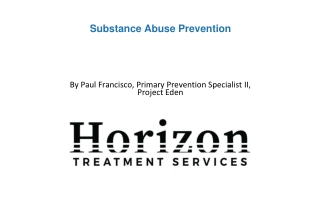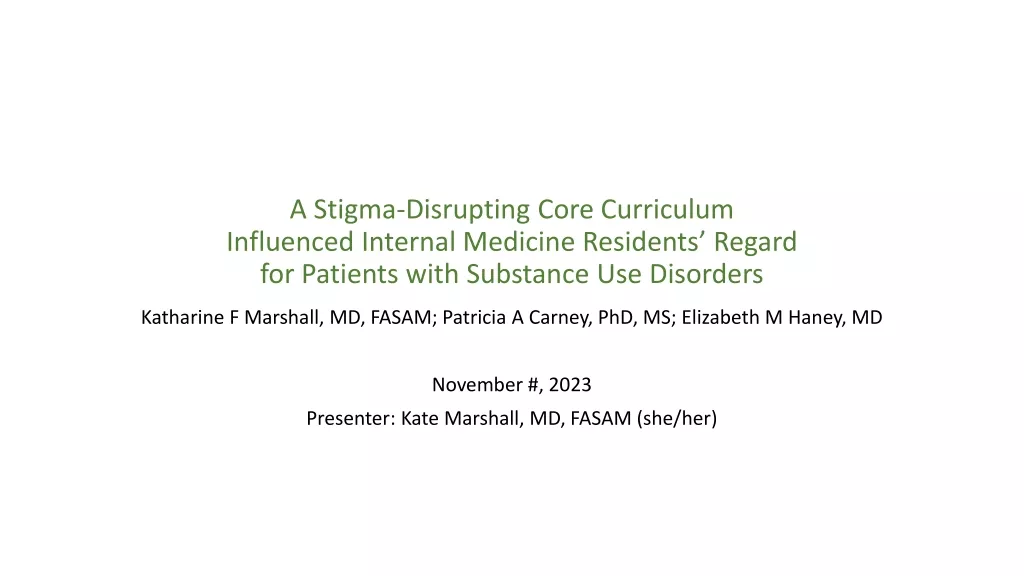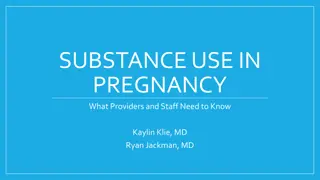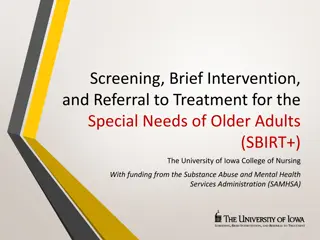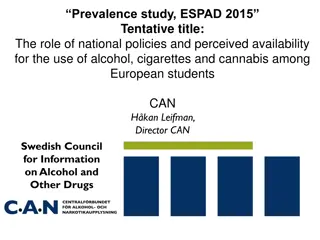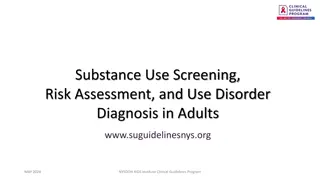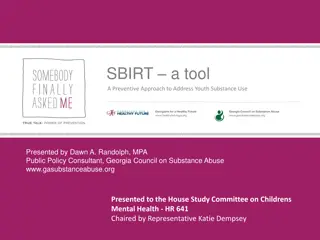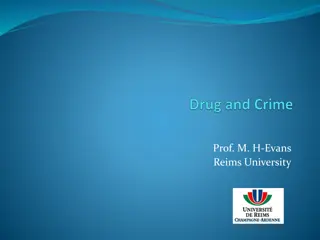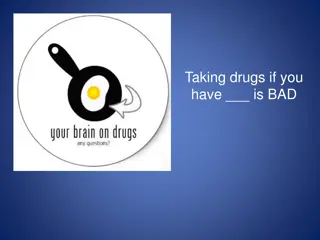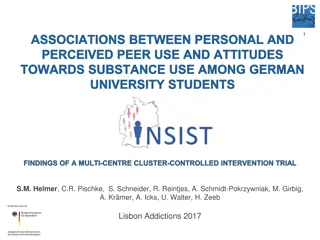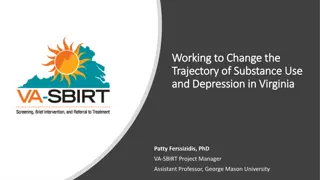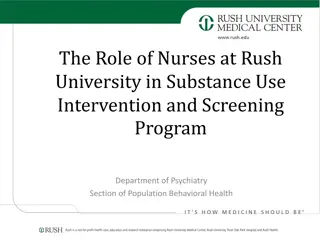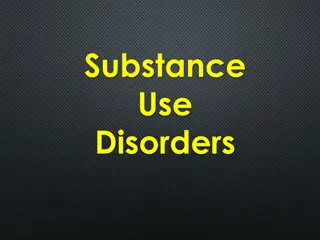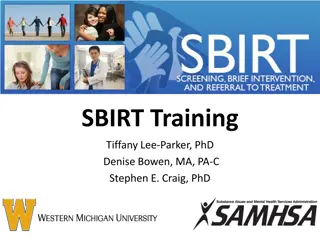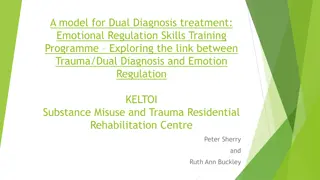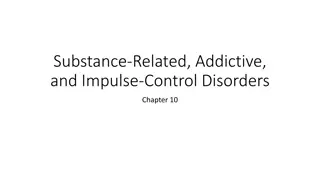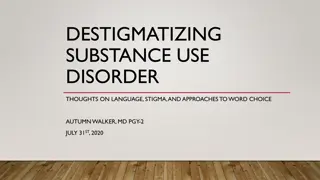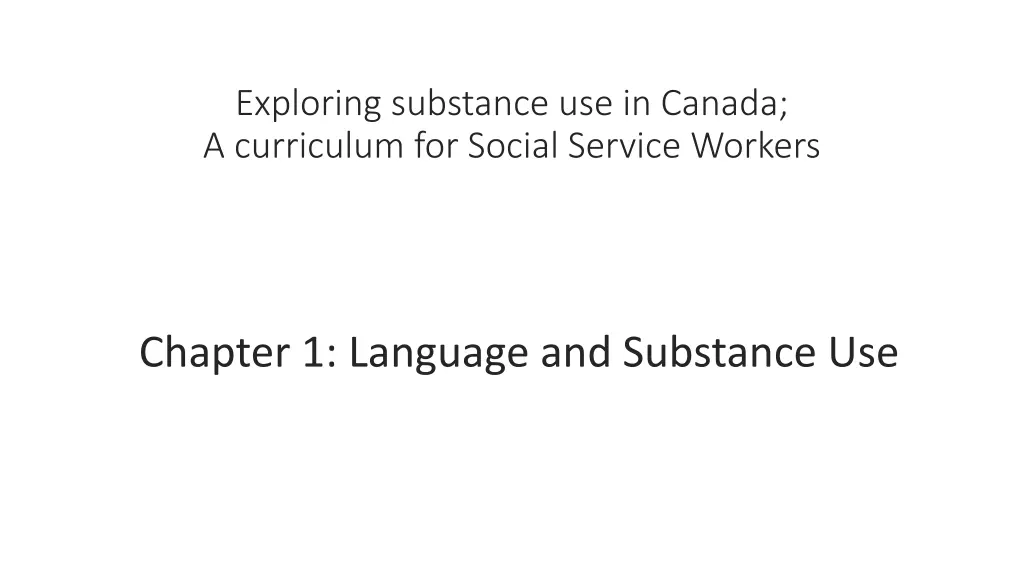
Understanding Social Determinants of Health in Substance Use Context
Explore the impact of social determinants of health on substance use in Canada. Learn about intersectionality, stigma, appropriate language use, and the role of compassion. Social determinants such as income, education, and race play crucial roles in shaping individual and population health outcomes. Gain insights on how these factors intersect and influence health disparities. Watch informative videos to deepen your understanding of these critical topics.
Download Presentation

Please find below an Image/Link to download the presentation.
The content on the website is provided AS IS for your information and personal use only. It may not be sold, licensed, or shared on other websites without obtaining consent from the author. If you encounter any issues during the download, it is possible that the publisher has removed the file from their server.
You are allowed to download the files provided on this website for personal or commercial use, subject to the condition that they are used lawfully. All files are the property of their respective owners.
The content on the website is provided AS IS for your information and personal use only. It may not be sold, licensed, or shared on other websites without obtaining consent from the author.
E N D
Presentation Transcript
Exploring substance use in Canada; A curriculum for Social Service Workers Chapter 1: Language and Substance Use
1. Recognize the role of the social determinants of health on individuals. 2. Define intersectionality. 3. Describe stigma. Learning Objectives 4. Recognize appropriate and inappropriate language regarding substance use. 5. Explain how language contributes to stigma. 6. Explain how stigma can impact a person s health. 7. Illustrate the role of compassion for others and self.
What are the social determinants of health? https://www.youtube.com/watch?v=plDaS8_LoYo (Public Health Agency of Canada, 2019).
The social determinants of health are the broad range of personal, social, economic and environmental factors that determine individual and population health (Government of Canada, 2020). This Photo by Unknown Author is licensed under CC BY-SA
Income and social status Employment and working conditions Education and literacy Childhood experiences Physical environments Social supports and coping skills Healthy behaviors Access to health services Biology and genetic endowment Gender Culture Race / Racism (Government of Canada, 2020). The social determinants of health include:
There are intersectionalities between the social determinants of health This means looking at the connections between the social determinants of health and how people experience the world differently. For example, examining gender and race together, rather than keeping each separate will help us provide a more comprehensive service to the people we work with.
A closer look at Intersectionality https://www.youtube.com/watch?v=rwqnC1fy_zc (Sociologial Studies Sheffield, 2020). (Sociologial Studies Sheffield, 2020).
Intersecting Intersecting isms can isms can create create inequalities if inequalities if we do not view we do not view them through a them through a lens of lens of intersectionality. intersectionality. Racism is the act of discriminating against someone based on their race/ ethnicity. Sexism is the act of discrimination against someone based on their sex or gender Ageism is the act of discrimination against someone based on their age Classism is the act of discrimination against someone based on their social class Disablism is the act of discrimination against someone based on their physical or psychological differences
The History of the word addiction The term has evolved and only came to use in the 17th century relating to substance use, with the medical conception of addiction beginning around the 19th century (Levine, 1978). The word Addiction is rooted in Latin and was used in the early Roman Republic as being bound to or enslaved by (Levine, 1978). It meant a person was bound to a creditor (as in a person owed something).
Changing The Language of Addiction Instead of: We could say: Addiction Substance Abuse Clean (That person is clean from drugs) Drug Addict Alcoholic
Why is our vocabulary surrounding substance use important? (Canadian Centre on Substance Use and Addiction, 2017).
How does stigma impact individuals living with substance use disorder? https://www.youtube.com/watch?v=NtxaFXThrzA (Northern Health BC, 2017).
How does stigma affect the health of a person living with a substance use disorder? Stigma can prevent individuals from accessing support due to self-stigmatization (lack of self- worth, low self-esteem). Previous poor experiences with healthcare or other services can also prevent a person from reaching out for support.
Where do we begin when it comes to reducing the stigma surrounding substance use disorders (SUD)? https://www.youtube.com/watch?v=23KMfX5R8lM (Canadian Centre on Substance Use and Addiction, 2019).
After watching this short film, make a list of what Social Service Workers can do to reduce stigma.
How we can we seek to eliminate the stigma and discrimination surrounding substance use and substance use disorders? https://www.youtube.com/watch?v=FowNgyoAhpc (Canadian Centre on Substance Use and Addiction, 2017).
The impacts of slavery, which existed in Canada (Cooper, 2006), and colonization of People of Color has been and is both overt, subtle, and systemic (Government of Canada, 2020). Indigenous people have also been impacted by racism and stigma through colonization. This racism extends through the language we use when it comes to substance use. Racism, stigma and substance use:
Language matters Addressing the language we use is an important part of addressing racism, reducing stigma, and supporting the health of minorities in Canada. For example, the intersectionality of black people's lives in Canada includes "age, gender, sexual orientation, ability, religion, immigration status, country of origin, socioeconomic status, and racialized identity" (Government of Canada, 2020, para. 6). For Indigenous Canadians intersectionality also exists between colonialism, residential schools, and trauma. "While the experiences of First Nations, M tis and Inuit in Canada are unique, they have all endured and pushed back against hundreds of years of colonization, persecution and on-going structural violence that was intended to push them to the margins of society (Interagency Coalition on AIDS & Development, 2019, p. 4).
Decolonizing Substance Use & Addiction: https://www.youtube.com/watch?v=j95ayhyadNE (TedxSFU, 2020).
How Can We Make a Difference? Actively talk about racism and how it exists in our lives. Address the language we use Address the language others use around us Support the health of minorities We can provide trauma and culturally sensitive programming to people who have a racialized identity Being aware of the correlation, and ensuring we use a people first language while supporting an individual who has experienced these things. Seek out training that can support your understanding of language, racism, and stigma. Reflect on our identity and begin to examine privilege, an invisible package of unearned assets (McIntosh, 1998). http://also-chicago.org/also_site/wp- content/uploads/2017/03/white-privilege.pdf Learn more about traditional or cultural ways.
The Intersectionality of Sex, Gender and Substance Use A person s biological sex (male or female), and how they identify (gender), plays a role in their substance use and development of substance use disorders. Researchers suggest there are environmental, sociocultural and developmental influences (Becker et al., 2017, para. 1) when it comes to sex, gender and substance use. Women living with a history of substance use and addiction encounter many barriers when trying to access forums that are directly related to their life issues (Paivinen & Bade, 2008, p. 215). Women as a gendered group face greater stigmatization than men for using drugs since they go against the character traits of perceived female identity. Feeling unsupported and judged (Eggertson, 2013, p. 1562) can negatively impact their mental health and may prevent them from further accessing health care. The stigma of substance use is also greater for mothers since they are expected to be the caregivers, raise children, and be more family oriented than fathers. (Lee & Boeri, 2017, para. 18). Race and gender, as intersections of identity, also play a role in substance use and the development of a substance use disorder.
https://www.youtube.com/watch?v=nP--FR198Cc (National Institute on Drug Abuse, 2019).
Sex Differences in Stages of Addiction Acquisition Escalation Maintenance Withdrawal Relapse Women Initial exposure to drug, food or activity. May experience more pleasurable responses to drugs than men (cocaine, amphetamine). More likely to self- medicate than men. Increase in amount and frequency of drug taking. For those at risk for addiction, escalation is more rapid than for men (gambling, alcohol, drugs). The addictive behavior is established and stabilizes. Females stabilize at higher doses of drug than do males. Side effects of drug use are greater for women. Female smokers report increased negative affect during withdrawal and experience a greater stress response than men do. Women are more likely to relapse than men and do so more sporadically. Men Initial exposure to drug, food or activity. Take drugs and engage in risky behaviors to be part of the group more than women do. Slower escalation than for women (gambling, alcohol, drugs). The addictive behavior is established and stabilizes. Males stabilize at lower doses of drug than do females. Men exhibit greater symptoms of withdrawal from alcohol than women. Men have longer periods of abstinence than women. https://www.ncbi.nlm.nih.gov/pmc/articles/PMC5120656/table/T1/?report=objectonly
The Language of Compassion Your role as a Social Service worker is not to diagnose or treat but to provide support and appropriate referrals. https://www.youtube.com/watch?v=RD0EOwWK8gI (Canadian Centre on Substance Use and Addiction, 2021).
Self Care Please complete the self care module and report back next class. This Photo by Unknown Author is licensed under CC BY-NC-ND
References Accurate Creative. (2019, May 28). Public Health Agency of Canada- Social Determinants of Health. [Video]. Youtube. https://www.youtube.com/watch?v=rwqnC1fy_zc Canadian Centre on Substance Use and Addiction. (2017). Changing the language of addiction, fact sheet. https://www.ccsa.ca/changing-language-addiction-fact-sheet Canadian Centre on Substance Use & Addiction. (2020). Managing stress anxiety and stress during Covid-19. https://www.ccsa.ca/sites/default/files/2020-04/CCSA-COVID-19-Stress- Anxiety-and-Substance-Use-Health-Care-Providers-Infographic-2020-en.pdf Canadian Centre on Substance Use & Addiction. (2021). My journey begins with compassion. [Video]. Youtube. https://www.youtube.com/watch?v=RD0EOwWK8gI Canadian Centre on Substance Use and Addiction. (2018). Stigma and Discrimination in the Language of Addiction, Dr. Kenneth Tupper. [Video]. YouTube. https://www.youtube.com/watch?v=FowNgyoAhpc Canadian Centre on Substance Use and Addiction. (2019). Illuminate. [Video]. YouTube. https://www.youtube.com/watch?v=23KMfX5R8lM Cooper, A. (2006). The hanging of Ang lique: The untold story of slavery in Canada and the burning of Old Montr al. University of Georgia Press. First Nations Health Authority. (2015). Decolonizing substance use. https://uphns-hub.ca/wp-content/uploads/2021/05/PowerPoint-Decolonize-Substance-Use-Indigenous-Harm- Reduction.pdf Government of Canada. (2020a). Social determinants of health and health inequities. https://www.canada.ca/en/public-health/services/health-promotion/population-health/what- determines-health.html Government of Canada (2020b). Social determinants and inequities in health for Black Canadians: A snapshot. https://www.canada.ca/en/public-health/services/health- promotion/population-health/what-determines-health/social-determinants-inequities-black-canadians-snapshot.html Interagency Coalition on AIDS & Development. (2019). Indigenous harm reduction, reducing the harms of colonialism, policy brief. https://www.canada.ca/en/public- health/services/health-promotion/population- health/what-determines-health/social-determinants-inequities-black-canadians-snapshot.html
ReferencesContinued Lee, B., Kellett, P., Seghal, K., & Van den Berg, C. (2018). Breaking the silence of racism injuries: A community-driven study. International Journal of Migration, Health, and Social Care, 14(1), 1-14. http://dx.doi.org/10.1108/IJMHSC-01-2016-0003 Lee, N., & Boeri, M. (2017). Managing stigma: Women drug users and recovery services. Fusio: the Bentley Undergraduate Research Journal, 1(2), 65 94. https://www.ncbi.nlm.nih.gov/pmc/articles/PMC6103317/ McIntosh, P. (1989). White privilege: Unpacking the invisible backpack. Peace and Freedom Magazine. https://psychology.umbc.edu/files/2016/10/White- Privilege_McIntosh-1989.pdf National Institute on Drug Abuse. (2019). Sex, gender and addiction. [Video]. Youtube. https://www.youtube.com/watch?v=nP FR198Cc North End Community Health Centre. (2021). 50 Years of NECHC. [Video]. Youtube. https://www.youtube.com/watch?time_continue=20&v=yN1GQ7_dkXo&feature=emb_logo Northern Health B. C. (2017, March 29). Stop stigma. Save lives: Experiences of stigma. [Video]. YouTube. https://www.youtube.com/watch?v=NtxaFXThrzA Paivinen, H., & Bade, S. (2008). Voice: Challenging the stigma of addiction -a nursing perspective. International Journal of Drug Policy, 19(3), 214-219 https://doi.org/10.1016/j.drugpo.2008.02.011 Royal College of Physicians and Surgeons of Canada. (2015, March 25). Bridging the gap between traditional and western medicine: The remarkable work of Dr. Karen Hill. [Video]. YouTube. https://youtu.be/nVQU1EmoWoU Sociological Studies Sheffield. (2020, Oct. 8). Intersectionality and health explained. [Video]. Youtube. https://www.youtube.com/watch?v=rwqnC1fy_zc Varin, M., Palladino, E., Hill MacEachern, K., Belzak, L. & Baker, M. M. (2021). At a glance: Prevalance of alcohol use among women of reproductive age in Canada. Health Promotion and Chronic Disease Prevention in Canada Journal, 41(9), 267-272. https://doi.org/10.24095/hpcdp.41.9.04

